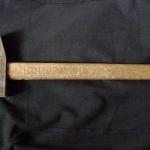The basement in the house acts as an additional air layer, which allows you to maintain normal temperature in the living quarters and prevent dampness from entering the house. Therefore, it is very important to maintain the basement in good condition. The first enemy of this room is dampness. This problem arises especially strongly in the off-season, when groundwater rises. Dampness in the basement provokes the appearance of fungi, which destroy all objects in the room and the walls of the room themselves. If the humidity level exceeds all existing standards, the dampness reaches the first floor of the house. High-quality waterproofing of foundations and basement walls helps to avoid all these troubles.
Why does dampness occur in basements?
If pockets of dampness are detected, you must first find their source.
- Often these are some areas of waterproofing that have lost their properties over time or were initially installed incorrectly. Another reason is the incorrect design of the foundation during the construction of the house, when the bottom slab lies below the groundwater level. But even if it is designed correctly, sediment streams and melt water act on the foundation of the building, saturating it with moisture.

- Another possible reason is an incorrectly constructed or lost integrity of the blind area. If moisture appears due to this, then it comes from outside and external waterproofing of the basement walls is required. This process is complex and labor-intensive, which involves demolishing the blind area, digging a ditch above the foundation walls, carrying out waterproofing work and constructing a new blind area and drainage.
- Condensate. It is formed due to the temperature difference between the outside and inside of the room. If the basement heating system is incorrect, warm currents interact with lower-temperature walls. Moisture in the air settles on cold surfaces. In this situation, the solution will be external waterproofing, as well as an improved heating system. If the basis of the structure is a steel frame made of reinforcement, internal waterproofing is also necessary.
Often there is a need to carry out waterproofing measures in rooms that are closely adjacent to other buildings. These are separate extensions to a private house or garages in cooperatives, which are built close to each other. In this case, there is no way to dig a trench to expose the foundation walls. For waterproofing in such a situation, a point method is used, which will be described below.
Types of waterproofing
The main division of waterproofing involves two types of work - vertical waterproofing and horizontal. Vertical waterproofing can be painted, when one or two layers of bitumen mastic are applied to the surface, or pasted, when roll material made on the basis of bitumen mastic is attached to the walls. Horizontal insulation is carried out using a solution of sand and cement, which is applied to the surface and reinforced on top with rolled materials. When choosing to insulate a basement from water, you should rely on data on the groundwater level relative to the lower part of the foundation:
- Low groundwater level in a building without a basement. Lay a mortar of sand and cement in a layer of 20-30 mm. The solution is leveled and roll materials are laid on it. The entire waterproofing system is located along the edge of the foundation at a height of 150-200 mm from the ground.
- Low groundwater level in a building with a basement. Lay vertical or horizontal insulation. Three arrangement options:
- Insulation is arranged according to the floor level. In a strip foundation, a solution of sand and cement is placed on top of the slab in a ratio of 1:2, the layer thickness is 20-30 mm.
- Insulation is installed along the edge of the foundation. Rolled materials are laid at a distance of 15-20 cm from the ground and placed on a leveled base.
- The walls of the room are painted with hot bitumen mastic.

- High groundwater level in a building with a basement. In this case, three types of waterproofing are also applicable:
- Laying a solution of sand and cement 20-30 mm thick.
- Laying 1-2 layers of rolled materials on a leveled base.
- If the groundwater level reaches 0.2 m, then it is necessary to perform vertical insulation. To do this, lay 2-3 layers of insulation on the base using bitumen mastic. A clay castle is also made from oily, wet clay.
Measures to externally prevent the appearance of dampness in the basement
Symptoms of improper insulation of the outside of the foundation include moisture accumulation, damp walls, leaks in the seams or between blocks. To remove these symptoms, you need to do the following:
- Dismantling the blind area around the perimeter of the house.
- Work on digging a trench along the foundation.
- Carrying out work to remove excess layers from the foundation walls.
- Cleaning the crumbling layer using a hammer drill or a metal brush.
- Waterproofing measures.
- Backfilling with sand or clay.
- Construction of a new blind area.

Dismantling the blind area and digging a trench
Waterproofing the internal walls of the basement begins with cleaning the old blind area. This work is carried out using a professional hammer drill with the required power level or a jackhammer. If the specified tools are not available, then make do with an ordinary crowbar. A trench is dug in width of a size that will be sufficient for all necessary manipulations. Most often, this size is 50-70 cm. A trench is dug in depth to the level of the bottom slab. This figure ranges from 70 to 150 cm.

Insulation condition analysis and repair work
After making the trench, the old wall insulation is inspected. In some cases, it is not necessary to completely change the waterproofing, since it has become unusable not over the entire area, but only in certain areas. In this case, materials similar to the already installed waterproofing are taken, or the most similar material is selected. For example, if the old waterproofing is made of bitumen, then it is repaired with bitumen mastic. Cement or polymer-cement coating is repaired with mixtures based on minerals or mineral-polymers. It is optimal to use not just similar material, but even material of the same brand.
The waterproofing coating cannot be repaired if it has a large number of cracks and various damages, or the surface has many rotten areas. In this case, it is necessary to completely dismantle the waterproofing and then replace it with another material.

Removal of old insulation and wall cleaning work
If the waterproofing is made with mastic or bitumen and its condition is assessed as not critical, the layer is reliable, but there are some places that are damaged, the layer is restored. Problem areas are treated with a composition similar to the old coating, then 2 more layers of waterproofing are applied to the entire surface. Before carrying out all work, the old coating is thoroughly cleaned.
First, all damaged areas of insulation are removed, then all dust and large contaminants are removed from the wall. Next, the surface is treated with a brush with metal bristles or a grinder with a special attachment. During stripping, the following principle is adhered to - all parts of the insulation that can be easily cleaned must be completely cleaned. Not only thin layers are removed, but also areas that are quite large in area and depth. The wall is cleaned to a monolithic layer of building material.

Waterproofing with bitumen
When the wall surface is completely prepared and all unnecessary layers are removed, proceed directly to treatment with waterproofing material. There are many methods of waterproofing, but the most budget-friendly and easiest-to-install option is bitumen mastic. This method is optimal for those people who do not have such work experience. To treat the surface you will need:
- Bitumen mastic.
- Bitumen primer.
- Construction brush.
- Respirator.
- White Spirit.
Before applying the insulation, the wall is once again thoroughly swept to remove sand and dust. A small layer of bitumen primer is applied to the cleaned area. It is applied in the same way as regular water-based paint. The thickness of the layer is determined by the color, which should be rich black. If the color is not dark enough, you need to add another layer. The primer is left until completely dry; in these works it acts as a primer impregnation.

After the primer has completely dried, mastic is applied to it. Most often, a ready-to-use mixture is sold, but if its thickness is too high for the job, then a little white spirit is added. The diluted mastic is thoroughly mixed. The operating temperature of the mastic is 40-50o; it is heated directly in the bucket. Apply the material with a brush or roller, and use a spatula for leveling. The mastic dries completely within a day; at low temperatures this period increases to two days. After the first layer has dried, apply the second. Vertical waterproofing of the basement walls has been completed.
Before backfilling the trench, consideration should be given to insulating the trench. This measure will make the room warmer and provide additional protection against condensation. External thermal insulation is carried out with expanded polystyrene or polystyrene foam. The sheets are fastened along the entire perimeter of the foundation.
Types of waterproofing from inside the basement
If moisture penetrates from outside, dampness accumulates inside the basement, waterproofing the basement walls from the inside will also help. This method, as already mentioned above, is recommended if it is not possible to get to the outside of the foundation. There are two options for internal insulation - penetrating or injection.

Injection insulation is the simplest and is used when a small amount of condensation appears. It is performed using fine bitumen; it is used as the basis for external insulation, described in the previous section. It is not recommended to use mastic in residential premises, as it is made with the addition of organic solvents.
Rules for performing penetrating insulation
If the concentration of condensate is high or groundwater penetrates into the room, rising above the floor level, more extensive waterproofing work is necessary. This applies to both waterproofing brick walls of basements from the inside, and work on other building materials. In this case, penetrating insulation is performed with penetrating compounds.

They begin work in the same way as external insulation - they clean the surface. All layers are removed to the base of the wall, then the building material is cleaned with a wire brush or grinder. Walls made of bricks or blocks require additional work. These include removing old mortar from the seams and making a U-shaped groove along the line where the walls meet the floor. The seams and grooves are filled with a repair mixture, for example, Penecrit. Be sure to treat the places where communication elements enter the foundation - pipes, vents, etc.
Surfaces cleared of debris and dust are moistened with a water jet unit or a hose with a special nozzle. Penetrating waterproofing is applied only to a damp surface; a brush with a dense bristled coating is used for application. The first layer is allowed to set well and immediately begins to apply the second.
The floor is treated in the same way. The only difference in the work is that after moistening there are puddles on the floor that need to be removed. All treated surfaces should not be exposed to sunlight, and they should also be protected from mechanical influences. After treatment, all surfaces are moistened for 10 days. This is done with a spray or simply retains moisture by covering the surface with plastic film. The room temperature is maintained at 50C.
One of the most important issues when building a house is. This is especially important when the project includes a basement. In this case, the external and internal tasks are of primary importance.
There are four main types of block foundation. It is concrete blocks that are most often used to construct the foundations of houses and other ancillary buildings and structures.
If a strip block foundation is used when building a house, then you must definitely pay attention to protecting the house from groundwater, melt water and wastewater. Before designing, it is imperative to carefully study the composition of the soil, the depth of freezing and the level of water.

If you are not designing a house yourself, but have hired a contractor, then pay attention to this part of the project. Groundwater is a source of dampness and the spread of fungus and mold. The main harm they can cause is the destruction of reinforcement inside foundation blocks and cushions. This will cause weakening of the supporting structure, which will lead to premature wear and destruction. When it comes to founding a residential building, there is no need to talk about the consequences. home basement becomes issue number 1.

There are vertical and horizontal waterproofing. The first is designed to protect the foundation walls, the second, respectively, from water coming from the depths of the soil and affecting the basement floor. Also, waterproofing of basements is classified according to the materials used in the following categories:
- Coating
- Pasting
- Plastering
- Bulk

For coating waterproofing, bitumen mastics or solid bitumen are used. Coating materials for waterproofing basements are mastic or molten bitumen, which is applied to the internal and external walls of the foundation with a brush or a wide brush. The mastic does not require melting and therefore is more convenient to use, since it does not harden for a long time when it cools. To make its consistency more liquid, just add a little gasoline.
Important to remember! When applying coating waterproofing, carefully rub the composition into the surface of the foundation block. Basement waterproofing technology does not allow for omissions or unpainting of small sinks.

Moisture can seep into the basement through unpainted areas. The adhesive waterproofing of basement walls is carried out using weld-on or self-adhesive roll materials. These are roofing felt, Akvaizol and similar materials. For their installation, gas burners are used, which preheat the material, and then glue it to the foundation walls.
The advantages of this waterproofing include sufficient simplicity and high speed of work. The disadvantages include the presence of joints between adjacent strips of adhesive waterproofing. They are the weak link through which groundwater can leak over time.

Plaster waterproofing of the basement outside and inside is done by plastering the surface of the foundation blocks with polymer-cement compounds. A special additive in the solution firmly seals the smallest pores and cracks of concrete blocks and pillows. The minimum thickness of plaster waterproofing is 15-20 mm. However, it should be noted that this process is costly and labor-intensive, but believe me, for the long-term use of your home, “the game is worth the candle.”
Self-leveling horizontal waterproofing of basement floors is also performed using one or two-component polymer compositions based on sand and cement. Typically, the basement floor is a concrete, monolithic reinforced slab, which is laid on a 15-20 cm thick cushion of compacted gravel and a layer of sand of the same thickness. The prepared solution is poured onto the floor twice with an interval of 6-12 hours. The waterproofing layer must be at least 2-3 mm.

Important to remember! To check the thickness of the floor waterproofing, you need to cut a 2 x 2 cm square of waterproofing anywhere with a sharp knife and measure its thickness with a micrometer.
Two situations often occur in practice:
- A house with a basement was bought and there is a lot of dampness there
- The construction of a house begins from the zero cycle (foundation)
Suppose you bought a house, and in the spring, after the snow melted, it turned out that the basement was saturated with moisture and mushrooms were blooming on the walls. How to waterproof a basement? There is no need to lose heart, but you should get to work.
The installation of basement waterproofing begins not in the basement, but at the top, or rather in the area adjacent to the perimeter walls of the house. First of all, inspect the blind area. This is part of the yard, at a distance of 1-1.5 m from the walls. It should not contain cracks or obvious defects.
Ideally, the blind area is done like this:
- The old covering 1-1.5 m from the walls around the house is removed
- A shallow trench is dug in this place (enough for a spade bayonet or 30 cm)
- A 10 cm layer of clay is poured and compacted (this is a hydraulic lock)
- A layer of gravel (middle fraction crushed stone) 10 cm and thoroughly compacted
- A 5 cm layer of sand is placed on top and compacted in the same way.
- Pour the prepared pie with a layer of concrete M 200 or 300 5 mm thick
- The concrete surface is carefully smoothed with a special trowel or plaster trowel.
Such a blind area will reliably protect the foundation from rain and melt water. After this, you can go down into the basement and begin waterproofing the walls. If the old basement floor screed has become weak and cracks have appeared on it, then it is recommended to remove it.
Rolled waterproofing (roofing felt) is laid on the prepared floor with an overlap of 10-15 cm. A reinforcing mesh with a cell of 100 x 100 mm is laid on top of the roofing felt and tied together with knitting wire. It is first recommended to lay a layer of expanded clay insulation at least 10 cm thick.
The waterproofing of the basement floor is completed with a cement-sand screed with a thickness of at least 50 mm. After it has completely dried and hardened (21 days), you can lay the floor covering.
Waterproofing the basement walls is done after waterproofing the floor. It is recommended to open the seams of concrete blocks (remove old cement mortar to a depth of 5 cm). The joints between the blocks must be sealed with a special sealant on the same sand-cement base with polymer additives (PENETRON and similar materials). Before this, the seams are treated with a deep penetration primer - it will improve the adhesion of the waterproofing material.
For final waterproofing, a liquid solution of a polymer-cement mixture is applied to the walls and floor with a wide brush or broom. It will saturate the concrete and reliably plug the smallest pores and cracks. Now your basement is reliably protected from dampness and groundwater.
Important to remember! Particular attention should be paid to waterproofing sewer and water supply pipes that pass through the foundation.

When the waterproofing of the walls is completed, we go outside again and inspect the drainage system of the yard. All rain and melt water should flow not under the walls of the house, but from it through prepared channels. It is recommended to add soil in the right places and arrange rain trays from elements of paving slabs. There should not be a single puddle around the house within a radius of 5-10 m after rain.
If you are building a house from scratch, then feel free to use all the methods of basement waterproofing described in this article. Don't skimp on foundation protection. Ultimately, your descendants will thank you for this.
The basement floor is susceptible to moisture. If you decide to concrete the cellar, then you should definitely install waterproofing. It will help keep the room dry.
General principles
Waterproofing can be done in the basement immediately during construction, as well as in the finished room, after a while. It is made using special materials, which are laid on the floor in several layers.
Some are trying to solve this issue by sealing. This is the wrong decision, since even a very good sealant at the joints will allow moisture to pass through. In addition, when choosing waterproofing and its installation, you need to pay attention to the height of the groundwater. Additional drainage may be needed.
An excellent option is to carry out work both on the outside of the basement and on the inside. Such waterproofing will reliably protect against any water. If work is carried out at the stage of building a basement, then it is necessary to strictly follow the plan. Work on waterproofing a clay floor in a cellar, as well as in any basement, should be carried out in the summer, in warm and dry weather.
Without waterproofing, concrete walls and floors in the basement will gradually crack and mold and mildew will develop. Well, the smell is unpleasant too. It is important to waterproof the earthen floor in the basement of a wooden house, since excess moisture can adversely affect the entire wooden structure.
Description of waterproofing methods
Waterproofing can be done in one of several ways, each of which is convenient and useful in its own way. When choosing an insulation method, you need to consider which waters are of greatest concern to you. It's one thing if you are afraid of flooding, but quite another if the moisture comes from groundwater or condensation drops on the wall.
Here are the main ways:
- Non-pressure waterproofing is responsible for preventing the penetration of rain and floods from floods.
- Anti-pressure. Used as protection against groundwater.
- Anticapillary. Helps with a large number of drops of moisture that collect on walls and in cracks.
In addition, there are additionally several ways to waterproof a basement floor specifically:
- The painting method is carried out if the room has high-quality concrete floors. The material for such insulation will be polymer-bitumen substances, as well as bitumen-rubber.
- Pasted waterproofing of the cellar floor. One of the most common methods; Helps with low humidity in the room. In this case, several layers of special material, most often roofing felt, are laid on the floor.
- Impregnation method. Impregnating mixtures are used before finishing the room. The basis for the material can be bitumen or polymer varnishes.
- Injection. Penetrating method, in which the gel is introduced into all cavities and openings. The method is difficult for non-specialists. A master is required to perform it.
- Cast insulation. The floor in the basement is completely filled with a special solution or mastic.
- Membrane. Roll waterproofing using membrane materials.
Which method to choose is decided individually by the owner, depending on the quality and material and financial costs. You should also pay attention to the mechanical impact on the walls and floor. Not every waterproofing can withstand significant impact.
Materials and main stages of work
After you have chosen how and with what to fill the floor in the basement so that there is no water, you need to start work. The steps may vary. First, let's look at the multilayer waterproofing device:
- Remove a small layer of soil. Then compact it.
- Place a layer of previously kneaded clay.
- Then we fill in 10 cm of crushed stone and sand.
- Concrete covering, rough version.
- On top there is euroroofing material, so that there are no gaps between the strips. To do this, lay the rolls overlapping. All joints should be soldered; the material should protrude onto the walls.
- Then polystyrene foam up to 5 cm thick is laid out.
- The reinforcement or mesh on which the concrete will be poured is attached.

If you choose penetrating waterproofing, you will need to wet the walls or floor in the basement. Then remove all mold that has accumulated in the room. Apply penetrating solution. To do this you will need a wide brush. Use a syringe to fill all cracks and voids.
After two hours, the waterproofing is considered ready; cement can be applied on top, if necessary. This method is very convenient in cold regions, since the absence of moisture in cracks increases the resistance of concrete to low temperatures.
When using the coating method, experts advise pouring a screed over bituminous materials. Ideally, you should use a polymer mastic, which is easier to apply and dries faster. The advantages of coating materials are that they are relatively affordable and also easy to handle, which has a positive effect on the speed of work.
It is important to note that penetrating and coating materials have less control over the pressure of groundwater, and therefore are best used in dry and hot climates.
The basement can be insulated from groundwater from the inside using liquid rubber (a bitumen-based substance). In addition, liquid glass is used. The base is sodium silicate, soda and sand. Liquid glass requires the presence of metal structures on the surface.
First of all, it is necessary to thoroughly dry the basement and ventilate it. Then, according to the instructions, apply liquid rubber, the advantage of which is the absence of seams and joints. It is necessary to make several layers, but each individually must dry and set. A concrete screed must be installed on top.
Finally
Instructions for waterproofing a basement are not particularly difficult. You just need to choose the appropriate material, as well as the application method. In addition, you should definitely take into account the climatic conditions of your region, since they determine how reliable waterproofing you need.
Protecting a basement from water is one of the main tasks during its construction. It includes a whole range of measures to ensure the watertightness of the basement walls and floor, as well as to prevent the rise of water inside the structure through the capillaries. The most reliable waterproofing can only be done at the construction stage; all subsequent work will be only half measures that will not give a long-term and sustainable result. But what to do if you bought a ready-made house and discovered that there is often water in the basement? What measures to take, what materials to use. In this article, we will tell you how to waterproof a basement in an existing building and what materials to use for certain jobs.
What type of basement waterproofing can it be?

Before moving directly to waterproofing materials, I would like to clarify what we will protect our basement from. In total, there are three types of waterproofing: anti-pressure, non-pressure and anti-capillary.
Anti-pressure waterproofing a basement is necessary when the groundwater level is higher than the basement floor, and sometimes the walls too, or if there is a seasonal rise to this level during spring floods. Such waterproofing is installed only on the outside of the wall and floor structure. Materials are used that can withstand so-called positive water pressure. This is when water presses its weight against the surface of a structure, such as a wall. But waterproofing the basement of a house from the inside with these materials is useless, since negative water pressure acts there, causing the material to separate from the surface. In addition to this, if groundwater is high, it would be a good idea to install drainage around the basement to drain the water into a drain well or sewer.
Non-pressure waterproofing the basement is to protect against water accumulated due to precipitation or floods. Of course, if anti-pressure waterproofing has already been carried out, then there is no point in non-pressure waterproofing. But if the groundwater level in the area is quite low and there is no likelihood of its seasonal rise, then you can only get by with non-pressure waterproofing measures, for example, coating the floor and foundation walls with bitumen mastic.
Anti-capillary waterproofing designed to prevent water from rising through capillaries in concrete foundation walls and floors. This will protect the structure of the house from destruction. If previously, to protect the walls of a house from rising moisture, they simply coated it with bitumen or covered the top of the foundation with roofing felt before arranging the walls, but today the use of penetrating waterproofing is gaining more and more popularity.
Waterproofing basements: materials and technologies
The modern market is saturated with various waterproofing materials. Conventionally, they can be divided according to the method of application and principle of action into several categories: coating, roll, water repellent, penetrating or injection. Each of them is good in its place.
Coating waterproofing materials
This very broad category includes a variety of emulsions, bitumen-based mastics that can be applied both cold and hot, thick-layer bituminous coatings, cement-based compositions, and polymer coating materials.

Mastics are made from special bitumen, which is refined with synthetic rubber, and do not contain solvents. They can be applied to any strong, stable base: concrete, brick, plaster, stone and others, after moistening them. After the mastic dries, a seamless, highly elastic film is formed on the surface. This coating covers all cracks, is not afraid of cold and heat, does not allow water to pass through, and is resistant to aggressive environments. Waterproofing a basement involves applying mastic to the outer wall of the foundation to protect it from groundwater and storm water. This material can only withstand positive water pressure. Although sometimes mastics are used to fill expansion joints, so be sure to read the instructions before purchasing.
For example, bitumen mastics “Elastopaz” and “Elastomix”, which are also called liquid rubber, are applied to the surface of the floor and walls of the basement from the inside. But remember, the material is not able to resist negative water pressure for a long time, therefore, if the external waterproofing of the basement is not done, then over time the liquid rubber may break and a leak will appear.
Thick-layer bituminous coatings One- and two-component ones are used only to protect house structures from pressure water; they are applied outside the foundation walls and before pouring the basement floor. Can be used on any mineral surfaces: concrete, brick, hollow blocks, sandstone, limestone, plaster, porous concrete and others.
Cement-based compositions can be divided into conventional cement coating waterproofing, cement coating waterproofing with a penetrating effect and auxiliary compositions.
Conventional cement coating waterproofing Also called armor, it can be applied to any mineral surface. Some materials, after application, can create an elastic coating that will bridge newly formed cracks even up to 2 mm wide.
Cement waterproofing with penetrating effect Use only on good quality concrete surfaces. If cracks and capillaries are larger than 0.4 - 0.5 mm, the material will not work.
Polymer coating waterproofing materials include polyurethane-based materials and universal materials based on MS polymers.
Polyurethane based materials used for durable waterproofing, used in liquid form, they are one or two-component coatings that are applied and harden in a cold state. It makes sense to apply these materials only on the side facing the water. In this case, it is first necessary to carefully prepare the base: it must be clean, dry, without flaws that could interfere with adhesion.
Universal waterproofing based on MS polymers combines the advantages of silicone and polyurethane. This material appeared on the market relatively recently, but has already gained confidence, as it provides reliable crack bridging up to 10 mm and water resistance at the level of a thick-walled coating, and is applied as easily as a conventional bitumen emulsion, again, on the side facing the water .
Pasting waterproofing materials

Pasted waterproofing is carried out using rolled materials by gluing them to the base in several layers. For this you can use roofing felt, stekloizol, glass roofing felt, hydrostekloizol, glass felt, hydroisol, hydrobutyl and others. Before installing the adhesive waterproofing, the surface must be carefully treated: leveled (irregularities up to 2 mm are allowed), dried, and primed with bitumen emulsion. The resulting coating is sensitive to mechanical damage, so it is imperative to protect it with a pressure wall.

These materials are a relatively new way to make a surface water-repellent. Water simply rolls off the surface treated with a water repellent. But when new cracks appear, the material is not able to heal them, and it does not penetrate deeply into the surface structure, no more than 5 mm, so over time it is washed out and weathered. Gradually, the water-repellent properties decrease: if the material is water-based, then after 1 - 3 years, and if it is solvent-based, then after 5 - 10 years.
Penetrating waterproofing

Used to ensure waterproofness of concrete structures. The composition applied to the surface is a mixture of Portland cement, active chemical additives and finely ground quartz sand. It must be applied to a damp surface, while the active elements react with water, resulting in the formation of crystals that fill all the pores, capillaries and cracks in the concrete and do not allow water to pass through. The penetration depth of crystals is from 15 to 25 cm, but some brands claim that their material can penetrate up to 90 cm deep.
Penetrating waterproofing is a great way to seal a basement from the inside. But at the same time, it has several disadvantages: it is used only on concrete surfaces, the concrete must be of good quality, with capillaries and cracks up to 0.4 mm deep.
When wondering how to properly waterproof a basement, pay attention to the fact that almost all materials offered on the market are suitable for external waterproofing: coating, pasting, water repellents, liquid rubber and others, and for internal waterproofing you can use penetrating waterproofing. In this case, the term internal waterproofing of the basement means protecting the basement from ground or storm water, as well as capillary water. Because if you want to protect the basement from water that may appear due to leaks of communications, i.e. inside the basement, then coating materials, mastics and emulsions can be used to waterproof the floor.

The situation when water enters the basement, but it is not possible to carry out full external waterproofing, is not uncommon. Quite often, there is simply no external waterproofing of the foundation, or it has collapsed over time. At the same time, it is not possible to dig out the foundation and carefully treat its surface due to the fact that the houses are too close to each other or for other reasons. That is why home owners are looking for opportunities to waterproof the basement with their own hands, without resorting to excavation work.
Important! We would like to warn you right away that for high-quality protection from groundwater, waterproofing will be required on the outside of the foundation walls. This is the only way moisture will not penetrate the walls and inside the basement, pressing the waterproofing material against the wall surface. If there is no external waterproofing of the foundation walls, water will penetrate into the thickness of the walls, and then into the basement.
Waterproofing a basement from the inside with your own hands can include several types of work, for example, anti-capillary protection of concrete walls and basement floors and protection with liquid rubber.
Among all the penetrating materials, the following can be distinguished:

- Mixtures that are applied to concrete surfaces both outside and inside structures to make them waterproof;
- Mixtures and compositions for sealing seams, cracks, joints. Used in combination with the first mixtures;
- Fast-hardening compounds that can stop a leak in a matter of seconds;
- Additives to concrete mortar that are used during the construction stage.
Before applying penetrating waterproofing to the surfaces inside the basement, it is necessary to clean the room and thoroughly prepare the concrete surfaces. This is some of the difficulty in using penetrating materials, since to clean and moisten the concrete you will have to use special equipment or do it manually. If the capillaries of the concrete are closed, the material will not be able to get inside.
Important! Penetrating waterproofing is applied only to wet concrete. It is better if it is freshly poured.
All cracks and cracks must be opened and cleared, and then sealed with material for joints and seams, for example, Penecrit.

Then, according to the instructions, a solution for walls and floors is prepared, for example, “Penetron”, and applied with a brush or roller in a layer of 1 - 2 mm. Then you need to let the first layer dry and absorb and repeat the operation. Reacting with water, the material forms hydrophobic crystals, which extend deep into the concrete structure by 10 - 15 cm, and sometimes more, clogging the capillaries and preventing water from penetrating not only into the basement, but also into the concrete structure.
Learn more about complex penetrating basement waterproofing video.
On the market you can choose a material more suitable for certain conditions: “Hydrohit”, “Lakhta”, “Kalmatron”, “Xipex”, “Maxill”, “Penetron”.
Basement waterproofing with liquid rubber
As an additional measure to the penetrating waterproofing of concrete, the walls and floor of the basement can be treated with liquid rubber - a modern polymer or bitumen waterproofing material.

For self-application, one-component materials are suitable, for example, “Elastopaz” and “Elastomix”, which can be applied with a roller or brush without heating. Moreover, work can be carried out at any time of the year. The compositions are sold ready-to-use; just open the bucket and mix thoroughly.
To waterproof a basement with liquid rubber, the surface on which it will be applied must be cleaned of dust and debris, dried if necessary, and leveled. In principle, careful leveling is not required, since the material itself will close all the cracks and bulges, forming a membrane, but if the height differences are too large, the material consumption will increase.
Then we apply a primer to the walls and floor, preferably the one recommended by the material manufacturer. Next, open the bucket and mix the contents using a mixing attachment on a drill.

We apply the material to the surface of the walls and floor with a roller, spatula or brush, paying special attention to irregularities, cracks and chips. And leave it to dry. After complete hardening, the material will resemble rubber.
Waterproofing with liquid rubber from the inside of the basement does not protect the walls from water penetrating into their thickness. Over time, the concrete will become saturated with water to such an extent that it will begin to tear the rubber away from the surface. Although the manufacturer claims that rubber penetrates up to 15 mm deep into concrete, in the event of severe groundwater or storm water pressure, this coating will last no more than 4 - 5 years.
Since such materials are not designed for negative water pressure, it is advisable to install pressure walls and screed the floor in a layer of up to 50 - 100 mm. This way you can guarantee no leaks for quite a long time.
Internal waterproofing of the basement is just an additional, auxiliary measure. It is not capable of providing maximum reliability. Therefore, at the first opportunity, it is still worth digging out the foundation and performing waterproofing correctly. If the groundwater is quite low and never bothers you, then sometimes it is enough to perform penetrating insulation from the inside using polymer materials or special cement-based plasters. But remember, this will not protect the walls from water accumulation.
Waterproofing the basement from the inside: video review
Kirill Sysoev
Calloused hands never get bored!
Content
The basement of a country house can perform many functions - a technical room, a food cellar, an underground garage. The trouble is if groundwater begins to penetrate into it. It is necessary to provide protection against leaks. If such work was not carried out during the construction phase, it can be done at any time from inside the basement.
Why do you need internal basement waterproofing?
If the house is built in an area where groundwater flows shallowly, then flooding is possible in the room located below ground level. This situation occurs when the protection is poorly made. It is possible that the aquifer has changed its level. The situation urgently needs to be corrected. If you do not waterproof the basement from the inside from groundwater, it is possible:
- the appearance of fungus;
- mold development;
- reinforcement corrosion;
- foundation destruction;
- food spoilage;
- disruption of the microclimate throughout the house.

Types of waterproofing
The most reliable thing is to make protection from the outside, then the rising liquid will press it towards the building, ensuring reliable insulation. If it is necessary to protect from the inside from seepage through small pores or cracks, two types of insulation are used - vertical and horizontal. The quality of the barrier is affected by errors during the execution of work:
- processing only walls and floors, without ceilings;
- lack of natural ventilation.
Vertical waterproofing of basement walls
If there is a need to waterproof basement walls from the inside against groundwater, a vertical method of protection is used. It is used in a situation where liquid seeps through cracks at the joints of the foundation, while the walls of the basement are level with the aquifer. The following methods are suitable for vertical flood protection:
- membrane;
- injection;
- coating – applying bitumen mastic;
- plaster with a polymer composition;
- barrier with liquid glass, rubber.
Horizontal
If the basement floor is at the level of the aquifer, liquid can seep into the room, and horizontal waterproofing of the basement floor is necessary. It is additionally performed on walls to a height of 30 centimeters. This protects the basement from capillary penetration of moisture and rising groundwater. The following leakage insulation is performed:
- roll method;
- by pouring polymer materials.

What materials are used
There are a huge number of materials for insulation. Often, in addition to ground seepage, communications leakage occurs. When choosing materials, it is necessary to take into account that penetrating protection will save you from groundwater, melt water, and capillary leakage. In case of communal accidents, mastics and coating emulsions are effective. The following materials are effective against leaks:
- roll insulation;
- penetrating compounds;
- liquid rubber;
- membrane film;
- liquid glass.
Roll insulation
Waterproofing the basement from the inside from groundwater, when floor protection is necessary, is done using a roll method. The bitumen-based material is glued overlapping onto the surface, the joints and seams are melted with a blowtorch. Bitumen mastic is used as glue. Subsequent work is carried out depending on the flood situation. If the water rises frequently, coat the top with 4 layers of bitumen; if rarely, two layers are enough. After drying, a concrete screed is made and the building can be used. Rolled materials for protection:
- roofing felt;
- hydroisol;
- linochrome

Penetrating basement waterproofing
This method is effective when the house has a cellar with high groundwater. Waterproofing of basement walls from the inside is carried out with a material made from a mixture of cement, fine sand and chemically active components. The composition penetrates 100 mm deep due to its viscous properties and then crystallizes. This protection method:
- prevents liquid from rising through capillaries;
- reduces corrosion of structures;
- increases frost resistance;
- Can be used in areas with food products.
Membrane
Waterproofing a cellar from the inside using a membrane method is effective. The lightweight film, 2 millimeters thick, does not overload the foundation, has an adhesive layer, and is easy to use. The following types of membrane coatings are used:
- PVC – prevents the penetration of groundwater, fireproof.
- TPO membranes are based on propylene and rubber, the disadvantage is their high cost. Used to protect the bathroom, kitchen, toilet;
- EPDM membranes made of synthetic rubber. Can protect the room at low temperatures.
Injection
Very reliable injection insulation not only protects surfaces, but also the entire structure of the building. The execution process is very labor-intensive - it is necessary to drill a huge number of holes into which a special composition is pumped using special injectors. Mixtures used in this work:
- cement - increase strength characteristics;
- polyurethane - pushes liquid out from the inside when expanding;
- epoxy - used only in the place where there is a leak;
- methyl acrylate - penetrate deeply and fill cavities.
Liquid rubber
If it is necessary to insulate the basement floor, it is good to use liquid rubber. Made on a bitumen base with the addition of latex, it creates a durable film on the surface. The elastic coating can also be applied by coating to walls and ceilings. A layer 2 millimeters thick is enough. The insulation technology is as follows:
- a special composition is applied to the cleaned surface for better adhesion;
- coat the surface, filling joints and cracks;
- dried;
- the top is plastered to press the film, otherwise the surface underneath may collapse.

Liquid glass
The ease of application and low material consumption distinguishes basement waterproofing from the inside from groundwater using liquid glass. Before application, the composition is diluted with water. It fills the pores and crystallizes when it hardens, thanks to this:
- improves resistance to fungi and mold;
- the strength of the structure increases;
- no moisture absorption;
- resistance to mechanical stress increases;
- provides good protection to decorative coatings.
Waterproofing the basement from groundwater with Penetron
How to waterproof a basement if moisture appears on the walls? High-quality coating is guaranteed by Penetron. The dry mixture is diluted to a liquid state with water and applied to the surface with a brush. Penetrates 200 millimeters inside walls, prevents the penetration of liquids, but allows steam to pass through. Can protect walls made of stone, brick, and can withstand any pressure of the aquifer. Features of the solution:
- convenient coating technology;
- does not require special preparation of walls;
- environmentally friendly;
- Apply only to a damp surface in 2 layers.

How to properly waterproof a basement from the inside? You need to follow certain recommendations:
- determine the depth of groundwater;
- inspect the premises;
- identify places where water flows;
- note the presence of cracks;
- pump out water if necessary;
- clean from dirt and dust;
- widen cracks;
- treat the surface with a primer to improve adhesion;
- choose the material and method of protection;
- perform insulation;
- dry the room;
- equip a ventilation system.
Prices for waterproofing a basement from the inside
Waterproofing your basement yourself from the inside will be inexpensive. First you need to choose a protection method suitable for your premises. Then find the materials required for the job in the catalog and buy them in the online store. It is better to entrust the insulation of basement rooms from moisture to representatives of specialized companies in the city. The price range in rubles is:
- surface insulation with “Penetron” – 900-1400/m2;
- sealing of interblock joints by penetration – 1700-2100/m/p.;
- surface injection – 22000-2500/m2;
- treatment with liquid rubber – 900-1200/m2.

















